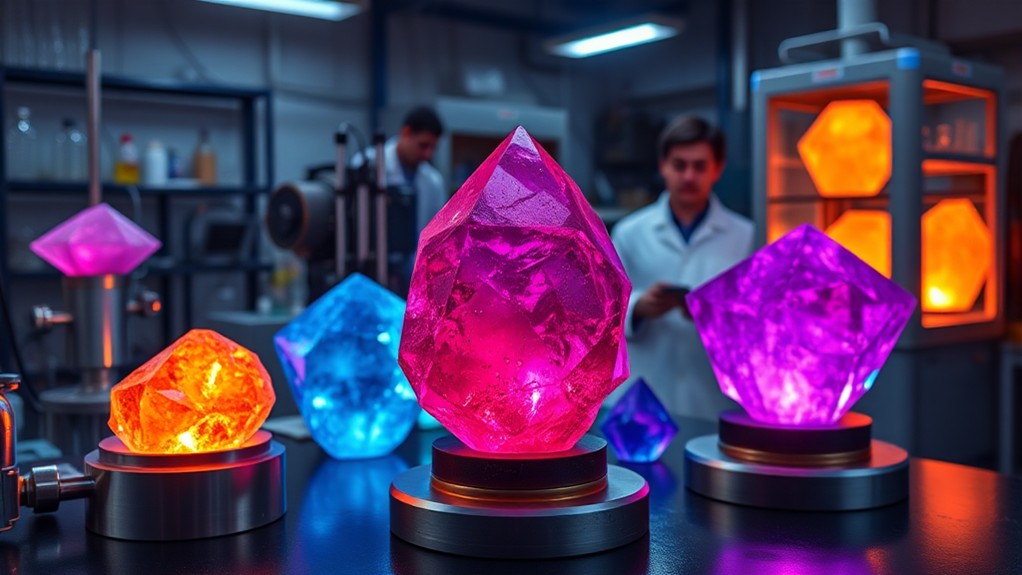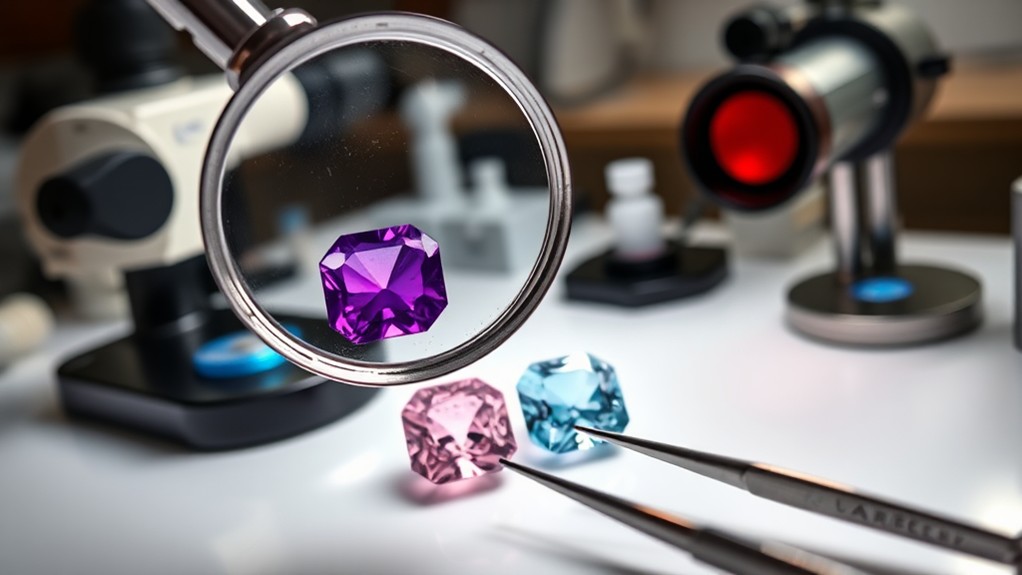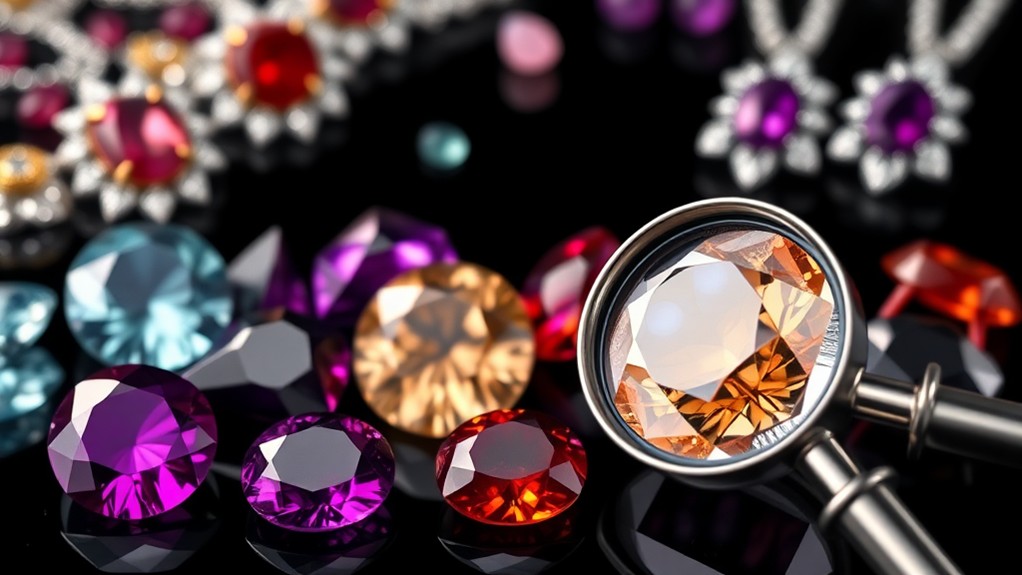You've likely heard of popular gemstones like diamonds and rubies, but have you considered the allure of spinel? This often-overlooked gem is gaining traction in the jewelry world, with both natural and synthetic varieties vying for attention. As you investigate the fascinating world of spinels, you'll uncover the key differences that set these stones apart, from their formation to their market value. Understanding the subtle distinctions between natural and synthetic spinels isn't just about aesthetics—it's vital for making informed decisions when investing in or purchasing these gems. So, what exactly makes a natural spinel more valuable than its lab-grown counterpart?
Our Highlighted Points
- Natural spinels have unique inclusions and higher market value due to rarity, while synthetics lack these imperfections.
- Authentication techniques include inspecting inclusions, analyzing growth lines, and conducting spectroanalysis to determine origin.
- Natural spinels typically command 30-40% higher prices than synthetic counterparts and are considered better investments.
- Synthetic spinels are produced using methods like flame fusion and flux growth, resulting in identifiable characteristics.
- Professional certification from accredited labs ensures authenticity and significantly impacts a spinel's market value.
Spinel Gemstone Overview

Three key attributes define spinel as a gemstone: its durability, colorful variety, and intriguing history. With a hardness of 7.5 to 8 on the Mohs scale, spinel is well-suited for everyday wear in jewelry. You'll find this versatile gemstone in a range of colors, including red, blue, pink, and black, thanks to trace elements like chromium, cobalt, and iron.
Spinel's physical properties contribute to its appeal:
- Moderate fire value of 0.020
- Refractive index ranging from 1.712 to 1.780
- Type II clarity classification
These characteristics improve spinel's brilliance and general appearance.
Historically known as "the great impostor," spinel was often mistaken for ruby until the late 18th century when it was recognized as a distinct gemstone.
When comparing natural and synthetic spinels, it's essential to recognize that natural counterparts typically command higher market value because of their rarity and unique inclusions.
These factors influence demand and pricing in the gemstone market. As you investigate spinel gemstones, consider their authenticity and origin to make informed decisions about their value and quality.
Natural Spinel Characteristics
Natural spinel stands out from its synthetic counterparts due to its unique characteristics. When examining natural spinel, you'll notice visible inclusions, such as octahedral shapes and mineral fragments, which are absent in flawless synthetic varieties. These inclusions classify natural spinel as a Type II clarity gemstone, indicating that it typically contains some imperfections visible under magnification.
Color variations in natural spinel result from trace elements present during formation. For instance, chromium creates red hues, while cobalt produces blue tones. These distinctive colors, along with clarity and size, considerably influence the market value of natural spinel, with rare hues like cobalt blue and vivid pink commanding premium prices.
Natural spinel's durability is remarkable, ranking 7.5 to 8 on the Mohs scale. This hardness makes it suitable for everyday wear in jewelry, resisting scratches and maintaining its luster over time.
When comparing natural and synthetic spinel, keep these key factors in mind:
- Inclusions: Present in natural, absent in synthetic
- Color origin: Trace elements in natural, artificial in synthetic
- Clarity: Type II in natural, often flawless in synthetic
- Value: Higher for natural, especially unique colors
Synthetic Spinel Production Methods

To understand synthetic spinel, you'll need to know about its two primary production methods: the Verneuil process and flux growth.
The Verneuil process, also referred to as flame fusion, involves dropping powdered chemicals through a flame, where they melt and crystallize into synthetic spinel. This method results in curved striae lines, which can indicate synthetic origin.
Flux growth, a more time-consuming and costly method, uses a solvent to lower melting points, allowing for controlled crystallization over an extended period, typically up to a year.
Both methods produce lab-created synthetic spinels that exhibit similar optical and physical properties to natural spinels. However, synthetic stones often lack the natural inclusions found in genuine stones.
The chemical composition of synthetic spinels can be tailored to improve specific characteristics. For instance, cobalt content in synthetic blue spinel produced via the Verneuil method deepens the color.
Moreover, the absorption spectrum of synthetic spinels differs from that of natural spinels, aiding in identification.
When examining a spinel, look for:
- Curved striae lines (Verneuil process)
- Absence of natural inclusions
- Differences in absorption spectra
- Unnaturally vivid or consistent coloration
Value Comparison: Natural Vs Synthetic
When comparing the value of natural and synthetic spinels, you'll find a significant price disparity. Natural spinel gemstones typically command a 30% to 40% higher market price than their synthetic counterparts of similar quality. This value difference stems from several factors:
- Rarity: Natural spinels are less abundant, increasing their perceived worth.
- Unique characteristics: Inclusions in natural stones contribute to their individuality.
- Historical significance: Natural spinels often have cultural or geological importance.
Synthetic spinels, while more affordable, lack the long-term investment potential of natural stones. However, they offer:
- Consistent clarity and color
- Fewer visible inclusions
- Greater accessibility for budget-conscious buyers
When evaluating spinel value, consider:
- Color: Cobalt blue and pink spinels are currently in high demand, affecting prices.
- Clarity: Natural stones may have inclusions, while synthetics tend to be flawless.
- Size: Larger stones generally command higher prices per carat.
Disclosure of origin is essential for informed purchasing decisions.
While synthetic spinels offer aesthetic appeal at a lower cost, natural spinels are often viewed as superior investments because of their potential for appreciation over time.
Authentication Techniques

Given the considerable value difference between natural and synthetic spinels, it's crucial to accurately authenticate these gemstones. When examining spinels, you'll need to look for specific indicators that differentiate natural from synthetic gems.
Start by using a loupe and bright light to inspect the stone for inclusions, as natural spinels typically contain visible imperfections, while synthetic variants often appear flawless.
Key authentication techniques include:
- Observing curved growth lines, indicative of the flame fusion process used in creating synthetic stones
- Detecting fine air bubbles, which are rarely found in natural specimens but common in synthetic gems
- Analyzing absorption and emission spectra through spectroanalysis and phosphorescence analysis
- Examining the stone's general clarity and color consistency
Advanced authentication methods can provide more definitive results.
Spectroanalysis and phosphorescence analysis are particularly effective in distinguishing between natural and synthetic spinels. These techniques analyze the stone's unique spectral characteristics, offering a more precise determination of its origin.
For the most reliable authentication, consider seeking professional grading and certification from accredited laboratories. This not only guarantees the spinel's authenticity but can likewise greatly impact its market value. When it comes to gemstones, a professional grading and certification can provide reassurance to potential buyers. It can also help differentiate between different levels of quality and clarify any diamond certificate differences. Ultimately, obtaining a reliable certification can give both the seller and the buyer peace of mind when buying or selling a valuable gemstone.
Market Demand and Trends
The spinel market has seen a significant shift in recent years, with natural spinels gaining popularity among collectors and jewelry enthusiasts. This surge in demand has been driven by several factors:
- Unique color properties and rarity of natural spinels
- Addition to the modern birthstone list for August in 2016
- Growing interest in untreated stones among buyers
As a result, natural spinels have experienced a notable increase in market value compared to synthetic alternatives. Cobalt blue and pink spinels, in particular, have become highly sought after, commanding higher price points in the gem market.
The rise of synthetic spinels has created a challenge for consumers, leading to unawareness regarding the differences between natural and lab-created stones. This has affected the general market dynamics and pricing structures.
To navigate these demand trends effectively:
- Educate yourself on the distinguishing features of natural spinels
- Be aware of the premium placed on untreated stones
- Consider the potential investment value of natural spinels in birthstone jewelry
As the market continues to evolve, staying informed about these trends will help you make well-informed decisions when purchasing or investing in spinel gemstones.
Jewelry Applications

Understanding market trends in spinel gemstones naturally leads us to investigate their distinct jewelry applications. Spinel gemstones, with their durability and assortment of colors, are increasingly popular in fine jewelry designs. You'll find these gems incorporated into engagement rings, necklaces, and earrings, offering a unique alternative to traditional stones.
Natural gems are particularly sought after for custom pieces, while synthetic spinels provide an affordable option without compromising on brilliance.
When considering spinel gemstones for jewelry, keep in mind their adaptability:
- Vibrant cobalt blue spinels set in white gold for a striking contrast
- Delicate pink spinels adorning rose gold engagement rings
- Classic red spinels paired with diamonds in vintage-inspired necklaces
- Black spinels creating bold, modern looks in statement earrings
The hardness of spinel (7.5 to 8 on the Mohs scale) makes it suitable for everyday wear, ensuring your jewelry maintains its beauty over time. This durability also makes spinel a popular choice for engagement rings and other frequently worn jewelry pieces. In addition, its versatility allows it to be paired with a variety of metals, including 24k, 18k, 14k gold karats, ensuring that spinel jewelry can complement any style or preference. Whether you prefer a classic yellow gold setting or a modern white gold look, spinel can be the perfect choice for a timeless and durable piece of jewelry.
Whether you opt for natural gems or those of synthetic origin, spinel's durability and broad color range allow for endless creative possibilities in jewelry design. From subtle accents to centerpiece stones, spinel gemstones offer a perfect balance of uniqueness and wearability in distinct jewelry applications.
Care and Maintenance
While spinel gemstones are known for their durability, proper care and maintenance are vital to preserve their beauty and value.
To maintain your spinel's brilliance, follow these important guidelines:
Cleaning:
- Clean your spinel regularly using mild soap and water.
- Use a soft cloth to gently polish the stone, enhancing its shine.
- Avoid harsh chemicals and ultrasonic cleaners, as they may damage the stone's surface.
Storage:
- Store your spinel jewelry separately from other gemstones to prevent scratching.
- Be especially cautious with harder stones like diamonds, which can easily scratch spinel.
Inspection and Maintenance:
- Regularly inspect your spinel's setting for signs of wear and tear.
- Confirm the gemstone remains securely held in place to prevent loss or damage.
Ethical Considerations

How can you guarantee your spinel purchase aligns with ethical standards? When considering natural or synthetic spinel, it's essential to weigh the ethical considerations associated with each option.
Natural spinel mining often leads to significant environmental impacts, including habitat destruction and pollution. In contrast, synthetic spinel offers an ethical alternative, created in laboratories without these negative consequences.
To make informed consumer choices, consider the following:
- Visualize a pristine laboratory where synthetic spinels are grown, free from environmental degradation
- Picture fair trade certified mines where workers receive proper wages and safe working conditions
- Imagine transparent supply chains that allow you to trace your spinel's path from source to store
- Envision sustainable mining practices that minimize ecological damage and promote habitat restoration
When purchasing spinel, prioritize transparency from jewelers about whether the stone is natural or lab-created.
Be aware that some natural spinels may be linked to unethical labor practices in certain mining regions. Opt for ethically sourced options by supporting brands that emphasize fair trade practices and environmental responsibility.
Frequently Asked Questions
Does Synthetic Spinel Have Any Value?
Yes, synthetic spinel has value. You'll find it's more affordable than natural spinel while still offering beauty and durability. It's popular in jewelry and appeals to cost-conscious buyers, though it lacks the investment potential of natural stones.
What Is the Difference Between Natural and Synthetic Spinel?
You'll find natural spinel forms in nature with unique inclusions, while synthetic spinel's made in labs. Natural stones are rarer, pricier, and vary in clarity and color. Synthetic ones are often flawless, cheaper, and show curved striae lines.
Is Natural Spinel Valuable?
Yes, natural spinel can be quite valuable. You'll find it's prized for its unique colors and inclusions. It's become more desirable since being added as an August birthstone. High-quality specimens, especially rare colors, command premium prices.
How Can You Tell if Spinel Is Synthetic?
You can spot synthetic spinel by looking for curved striae lines, perfectly round bubbles, and extreme flawlessness. Natural spinel often has visible inclusions like needles or fingerprints. Advanced techniques like microscopy and spectroscopy can additionally help you identify synthetics.


